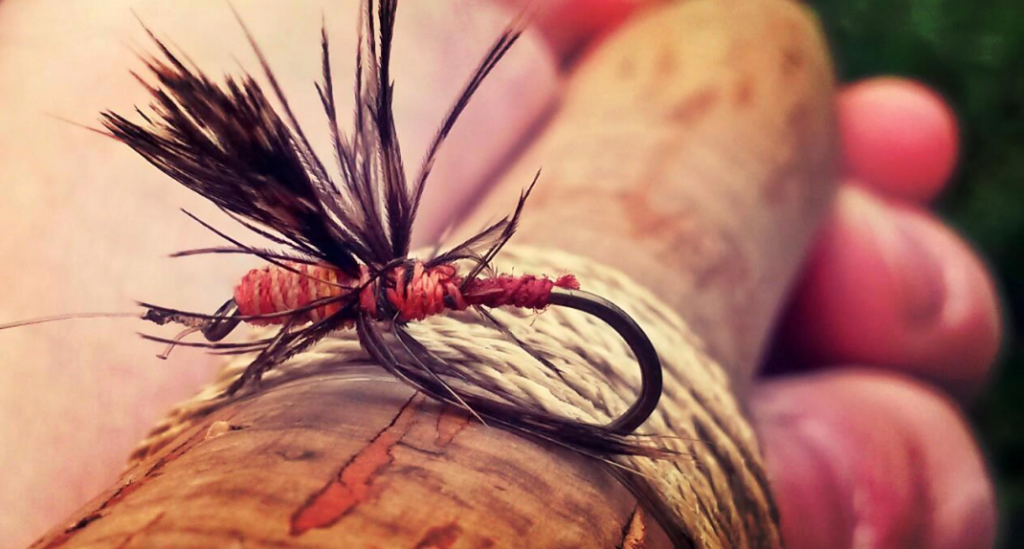Even as a kid I knew that the giant bluegills out in Hodges Pond were going to hit on the worms in my tin cup. We all know how fun that can be. If I could catch them, I was sure to get some action on the giant hoppers playing in the tall grass in the summertime. Those were givens, as were cheese, bread, and hotdogs. I spent a lot of time on the water wondering what else I could use, and how I could make it work. Would a piece of gummy worm or strawberry work? What I was figuring out is tha’s it’s all about presentation.
For decades I’ve heard the “match the hatch” philosophies behind fly fishing. I clearly understand where that comes from, why that works, and how to capitalize on the process. Sometimes I wonder if that is a bit like those worms and hoppers that I know will get hits. For me, I more often use a “scratch the hatch” method when choosing a fly for my local trout waters.
It isn’t right or wrong. It suits what I’m rying to do. I may let color and size of area insects influence my final fly choices, but the patterns I’ve tied up are not designed to match anything. This is the “what else” I’ve been thinking of for decades.
Tenkara flies have a heritage that dates back centuries. Known as “kebari”, they have been developed and improved upon until they were proven as regional “best picks.” We most often see the iconic “sakasa kebari”, or the reverse soft hackle fly, associated with tenkara. There are many more fly patterns than just this one. You will find those options out there with a little research at sites like the Japanese “My Best Streams: Tenkara Flies” This is an excellent resource of photos and explanations to discover ideas for your own fly tying adventures.
Something to notice with the Japanese kebari, especially the sakasa, is that they are for the most part simple. There is a fly body with a feather turned into it with not much more to it. I use words like “non-descript” and “buggy” to characterize them. These flies are as effective as anything from your local fly shop when they are fished. Like my earlier thoughts about “what else”, I realize that it is all about presentation.
With my very long tenkara rod, I can manipulate a fly in many ways. Since my line is off the water I can master extreme dead drifts. We can hold the flies in the film. We can sink them using currents. They pulse with incredible action in that reverse hackle. They slow troll as small streamers. These flies encourage you to learn a new bag of tricks.
The functional parts of tenkara are the rod, the line, and the fly. The simplicity behind this puts emphasis on presentation and technique over attention to gear and over thinking. It doesn’t take much to get down to business. The “sakasa kebari” is designed to be simple and incredibly effective. A crisp clean fly can be tied with floss or you can use sewing thread to develop nice textured bodies. They can be tied as “works of art” or can be tied up as a mess. A very respected Japanese fly tier, Mr. Shotaro Ishimaru, is known for the wily look of his flies where never the two are the same. Read a bit about Mr. Ishimaru here. I have lost control a few times in my turns and taken from the vise a gnarly half squished I don’t know what, like the one below. Those go into my fly box just the same.
Learning to tie the flies is very easy. There are hundreds of videos and step-by-steps to follow along with already posted online. A handful of #12 scud hooks, some sewing thread and a hen cape will get you started. Once you get started you can play with bead heads and lead-free under body wraps if you like. You can go bigger or smaller.
You can use longer dry fly hackle with three turns to get a sparse profile or tie in six turns of a brahma hen for a hefty look. If you already have a large box (or five) of tying materials then you are all set. Reach in there and get at it. Do you make your own dubbing? Is your secret ingredient the undercoat and guards hairs of a certain dog? Incorporate the things you already know. It has it’s own rewards.
Simplify a few of your “go to” patterns or pick up something new in your poking around and fish them with a commitment to making them work. Whether you are trying this on a tenkara rod or a western rig it should make no difference. Find the difference that presentation can make and it can change every aspect of your angling experience for the better.
—Jason Sparks is the Founder of the Appalachian Tenkara Anglers











